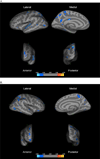Widespread reductions in cortical thickness following severe early-life deprivation: a neurodevelopmental pathway to attention-deficit/hyperactivity disorder
- PMID: 24090797
- PMCID: PMC3969891
- DOI: 10.1016/j.biopsych.2013.08.016
Widespread reductions in cortical thickness following severe early-life deprivation: a neurodevelopmental pathway to attention-deficit/hyperactivity disorder
Abstract
Background: Children exposed to early-life psychosocial deprivation associated with institutional rearing are at markedly elevated risk of developing attention-deficit/hyperactivity disorder (ADHD). Neurodevelopmental mechanisms that explain the high prevalence of ADHD in children exposed to institutionalization are unknown. We examined whether abnormalities in cortical thickness and subcortical volume were mechanisms explaining elevations in ADHD among children raised in institutional settings.
Methods: Data were drawn from the Bucharest Early Intervention Project, a cohort of children raised from early infancy in institutions in Romania (n = 58) and age-matched community control subjects (n = 22). Magnetic resonance imaging data were acquired when children were aged 8 to 10 years, and ADHD symptoms were assessed using the Health and Behavior Questionnaire.
Results: Children reared in institutions exhibited widespread reductions in cortical thickness across prefrontal, parietal, and temporal regions relative to community control subjects. No group differences were found in the volume of subcortical structures. Reduced thickness across numerous cortical areas was associated with higher levels of ADHD symptoms. Cortical thickness in lateral orbitofrontal cortex, insula, inferior parietal cortex, precuneus, superior temporal cortex, and lingual gyrus mediated the association of institutionalization with inattention and impulsivity; additionally, supramarginal gyrus thickness mediated the association with inattention and fusiform gyrus thickness mediated the association with impulsivity.
Conclusions: Severe early-life deprivation disrupts cortical development resulting in reduced thickness in regions with atypical function during attention tasks in children with ADHD, including the inferior parietal cortex, precuneus, and superior temporal cortex. These reductions in thickness are a neurodevelopmental mechanism explaining elevated ADHD symptoms in children exposed to institutional rearing.
Keywords: Attention-deficit/hyperactivity disorder (ADHD); brain development; childhood adversity; cortical development; deprivation; institutionalization.
Copyright © 2014 Society of Biological Psychiatry. Published by Elsevier Inc. All rights reserved.
Conflict of interest statement
All authors, including Drs. McLaughlin, Sheridan, Fox, Zeanah, and Nelson and Mr. Winter, declare that they have no biomedical financial interests or potential conflicts of interest.
Figures

References
-
- Polanczyk G, Silva de Lima M, Horta BL, Biederman J, Rohde LA. The worldwide prevalence of ADHD: A systematic review and metaregression analysis. American Journal of Psychiatry. 2007;164:942–948. - PubMed
-
- Scahill L, Schwab-Stone ME. Epidemiology of ADHD in school-age children. Child and Adolescent Psychiatric Clinics of North America. 2000;9:541–555. - PubMed
-
- Martinussen R, Hayden J, Hogg-Johnson S, Tannock R. A meta-analysis of working memory impairments in children with attention-deficit/hyperactivity disorder. Journal of the American Academy of Child & Adolescent Psychiatry. 2005;44:377–384. - PubMed
-
- Konrad K, Neufang S, Hanisch C, Fink GR, Herpertz-Dahlmann B. Dysfunctional attentional networks in children with attention deficit/hyperactivity disorder: evidence from an event-related functional magnetic resonance imaging study. Biological Psychiatry. 2006;59:643–651. - PubMed
Publication types
MeSH terms
Grants and funding
LinkOut - more resources
Full Text Sources
Other Literature Sources
Medical

